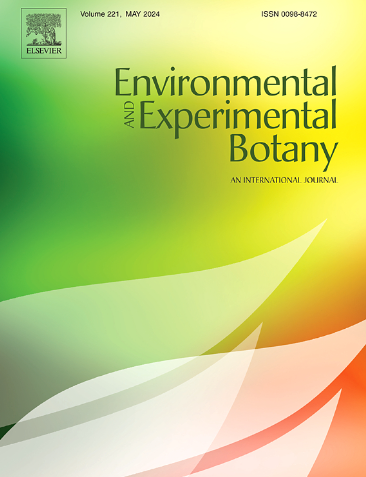从信号感知到适应性反应:镉、铅和铝胁迫下植物机制的综合综述
IF 4.7
2区 生物学
Q2 ENVIRONMENTAL SCIENCES
引用次数: 0
摘要
重金属(HMs)是人类产生的污染物,严重影响作物产量。有机污染物对土壤和水体的污染构成了严峻的环境挑战。虽然有机污染物作为稀有元素自然存在于土壤中,但农业实践、垃圾倾倒、冶金和制造业使其以更高的浓度向环境扩散,从而对农作物和人类健康产生负面影响。即使在低浓度下,镉(Cd)、铅(Pb)和铝(Al)等重金属也会对根系的吸收和向营养器官和生殖器官的运输产生不利影响,破坏矿物质营养和体内平衡,进而影响植物芽和根的生长发育。植物从受污染的土壤或水中吸收HMs,这抑制了根的生长,导致叶片褪绿,阻碍气孔打开,并可能导致枯萎或死亡。此外,它抑制光合作用和蒸腾作用,诱导氧化应激,改变酶活性,修饰基因表达。在生长和防御之间的资源分配是植物生存和适应的关键权衡。在重金属暴露下,更强的防御反应往往伴随着生长减少,即使没有明显的损害。植物已经进化出复杂的信号网络,通过信号蛋白,如质膜受体和离子转运体,以及激酶和其他酶的级联反应来响应环境刺激,最终导致效应物的激活。在植物对HMs胁迫的反应中,关键的信号传导作用是由激素和许多其他化合物发挥的,包括第二信使如胞质Ca2 +、活性氧(ROS)、活性氮(RNS)和环核苷酸如环腺苷单磷酸(cAMP)和环鸟苷单磷酸(cGMP)。此外,最近有研究表明,核苷酸如外源ATP (eATP)也可以在植物细胞中发挥信号传导作用。这些是调控网络的一部分,涉及MAP激酶、SnRK和转录因子,导致能够减轻HMs引起的植物胁迫的代谢物的合成。它们的吸收触发了多种表观遗传机制,可能促进或阻碍植物的抗逆性。在暴露于HMs后,植物通过DNA甲基化、组蛋白乙酰化和microrna介导的基因沉默来调节基因表达。最近的研究结果还强调了表观遗传机制作为信号网络中重要的转录后调节因子的参与,进一步微调了植物对HMs的反应。然而,还需要更多的研究来确定参与这一过程的信号网络。本文综述了目前对Cd、Pb和Al胁迫的感知、信号转导和植物反应的理解。本文章由计算机程序翻译,如有差异,请以英文原文为准。
From signal perception to adaptive responses: A comprehensive review of plant mechanisms under cadmium, lead, and aluminum stress
Heavy metals (HMs), pollutants produced by humans, significantly impact crop yields. The contamination of soil and water by HMs poses a serious environmental challenge. Although HMs naturally occur in the soil as rare elements, agricultural practices, refuse dumping, metallurgy, and manufacturing contribute to their environmental spread in higher concentrations that lead to negative effects on crop plants and human health. Even at low concentrations, HMs, such as cadmium (Cd), lead (Pb), and aluminum (Al), adversely impact root uptake and transport to vegetative and reproductive organs, disrupting mineral nutrition and homeostasis, which in turn influence the growth and development of both plant shoots and roots. Plants absorb HMs from contaminated soil or water, which inhibits root growth, causes leaf chlorosis, hinders stomatal opening, and can lead to wilting or death. Additionally, it suppresses photosynthesis and transpiration, induces oxidative stress, alters enzyme activity, and modifies gene expression. Resource allocation between growth and defense is a key trade-off for plant survival and fitness. Under heavy metal exposure, stronger defense responses often coincide with reduced growth, even without visible damage. Plants have evolved complex signaling networks that respond to environmental stimuli through signaling proteins, such as plasma membrane receptors and ion transporters, as well as cascades of kinases and other enzymes, ultimately leading to the activation of effectors. In the plant response to HMs stress, the pivotal signaling role is played by hormones and many additional compounds, including second messengers such as cytosolic Ca2 + , reactive oxygen species (ROS), reactive nitrogen species (RNS), and cyclic nucleotides such as cyclic adenosine monophosphate (cAMP) and cyclic guanosine monophosphate (cGMP). Moreover, it has recently been demonstrated that nucleotides such as exogenous ATP (eATP) can also play signaling roles in plant cells. These are part of the regulatory network, involving MAP kinase, SnRK, and transcription factors, that leads to the synthesis of metabolites capable of mitigating plant stress caused by HMs. Their uptake triggers diverse epigenetic mechanisms that may either promote or hinder plant stress tolerance. In response to HMs exposure, plants adjust gene expression through DNA methylation, histone acetylation, and microRNA-mediated gene silencing. Recent findings also highlight the involvement of epigenetic mechanisms as important post-transcriptional regulators within this signaling network, further fine-tuning plant responses to HMs. However, more research is still needed to identify the signaling networks involved in this process. This review summarizes the current understanding of perception, signal transduction, and plant responses to Cd, Pb, and Al stress.
求助全文
通过发布文献求助,成功后即可免费获取论文全文。
去求助
来源期刊

Environmental and Experimental Botany
环境科学-环境科学
CiteScore
9.30
自引率
5.30%
发文量
342
审稿时长
26 days
期刊介绍:
Environmental and Experimental Botany (EEB) publishes research papers on the physical, chemical, biological, molecular mechanisms and processes involved in the responses of plants to their environment.
In addition to research papers, the journal includes review articles. Submission is in agreement with the Editors-in-Chief.
The Journal also publishes special issues which are built by invited guest editors and are related to the main themes of EEB.
The areas covered by the Journal include:
(1) Responses of plants to heavy metals and pollutants
(2) Plant/water interactions (salinity, drought, flooding)
(3) Responses of plants to radiations ranging from UV-B to infrared
(4) Plant/atmosphere relations (ozone, CO2 , temperature)
(5) Global change impacts on plant ecophysiology
(6) Biotic interactions involving environmental factors.
 求助内容:
求助内容: 应助结果提醒方式:
应助结果提醒方式:


